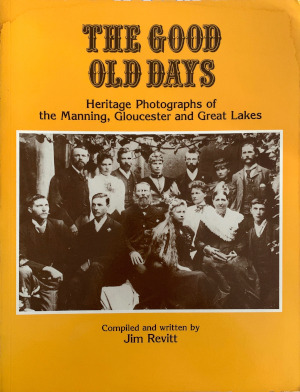
Compiled and written by Jim Revitt
“In 1978 I set out on what I expected to be a pleasant but short journey into the past. The aim of the exercise was to produce a book of old photographs that reflected the spirit as well as the achievements of the pioneering days along the Manning and around the Great Lakes. Now, four years and three books later, the journey has at last come to an end. It lasted much longer than I expected, yielded more great photographs than I initially imagined existed, and gave more pleasure than I can describe.
The sense of achievement that I feel at having published for posterity such wide-ranging images of our heritage must be shared by the persistent and hard working members of the Historical Societies of the region. Without their resources and help, the task would have been an impossible one. The fact that we have three volumes instead of the originally anticipated single book is due largely to the recognition by scores of people in the Gloucester, Manning and Great Lakes region that they had in their possession valuable historical photographs that should be shared with the community at large. To their awareness, and to the unknown photographers of bygone days, we all owe a great debt.
Over the past four years I have developed a much greater respect for the value of old photographs as a source of information for the historian as well as the general reader. In the books I have tried to give the pictures a chance to make their own statement. Their value will, I’m sure, increase with the years, and their message to future generations may well be more significant than what they have to say to us today.”
Jim Revitt
Second-hand book – fair – good condition
99 pages with black and white photographs
28cm x 21.5cm
Reprinted 1982 (now out of print)
Cost $25.00
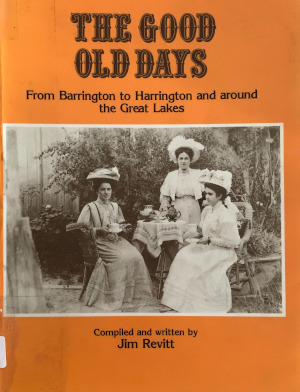
Compiled and written by Jim Revitt
Introduction
“In the introduction to “The Good Old Days along the Manning River and Great Lakes” I expressed the hope that the book would bring to light more old photographs of the past that had been saved by descendants of the pioneers of the area. The response from the public exceeded all expectations, and scores of people came forward with valuable photographs. The amount of fresh material, and the enthusiasm of the public for “The Good Old Days”, made a second book imperative. Such a wealth of exciting photographs had to be recorded and shared.
Once again, the Wallamba District Historical Society and the Manning Valley Historical Society have played a major role in the production of this second volume of “The Good Old Days”, richly supported by the Gloucester District Historical Society. The scope of this book has been extended to include the Gloucester area because there were strong economic and family links between the pioneers of Gloucester and the pioneers of the Manning and Great Lakes. Also, the photographs from Gloucester sources greatly enriched the stock of visual images that appeal so strongly to Australians with an appreciation of their heritage.
Tribute must again be made to the photographers who recorded these fascinating portraits of the past. Every effort has been made to trace copyright and any possible infringement is regretted.
While every effort was made to authenticate the text in the first volume of “The Good Old Days”, it was inevitable that some mistakes should have been made. Identifying people and places in old photographs so often depends on failing and faulty memories, or on information handed down verbally from generation to generation. Corrections to captions in volume one are printed on this page.”
Jim Revitt
Second-hand book – fair – good condition
99 pages with black and white photographs
28cm x 21.5cm
Reprinted 1980 (now out of print)
Cost $25.00
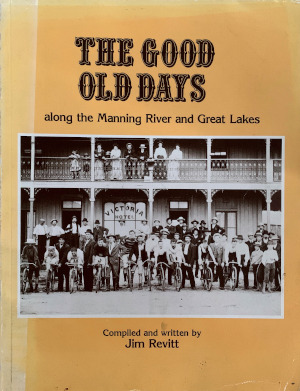 Compiled and written by Jim Revitt
Compiled and written by Jim Revitt
Introduction
“In recent years Australians have been looking at their past with a new awareness of their inheritance. As the nation approaches it’s bi-centenary, there is a growing sense of history that’s not restricted to those whose ancestors played a pioneering role.
In seeking out and understanding the roots of our heritage, it is very enriching to look at local history, as well as the people and events that dominated the national scene. The struggles and achievements of men and women far removed from the major centres of power and settlement are rich sources for anyone seeking a comprehensive picture of the past.
Unfortunately, very few pioneer communities in the bush were blessed with historians and diarists, and later generations recklessly destroyed much valuable material that had been handed down. Yet, despite these handicaps, there is still a great deal of useful historical material waiting to be salvaged by the custodians of local history. Happily, their ranks and resources are growing stronger.
In this book I’ve tried to record for wider appreciation some of the fascinating historical photographs of the past along the Manning River and Great Lakes, including Tuncurry and Forster. I’ve also endeavoured to background the photographs with historical facts, and colour them with human interest stories. A key objective has been to preserve some of these fast-fading images of an important era of our history and, in doing so, stimulate greater interest in local history. The book makes no pretension to be a definitive local history. That important task must eventually be taken by a trained historian.
The production of this book would not have been possible without the tremendous amount of work done over the years by members of the Manning Valley Historical Society, and I am deeply indebted to them. In return, I hope that sales of the book will financially benefit the Societies and encourage greater public support for their work.
I am indebted to the scored of photographers, most of them anonymous, who so faithfully and imaginatively recorded so many facets of the past. The photographs selected for this volume represent only a fraction of those now in public archives and private collections. Perhaps many more will be dug out of family collections as a result of this publication to provide additional material for another volume.
Every effort has been made to trace copyright and any possible infringement is regretted.
Jim Revitt
Second-hand book – fair – good condition
99 pages with black and white photographs
28cm x 21.5cm
Reprinted 1979 (now out of print)
Cost $25.00
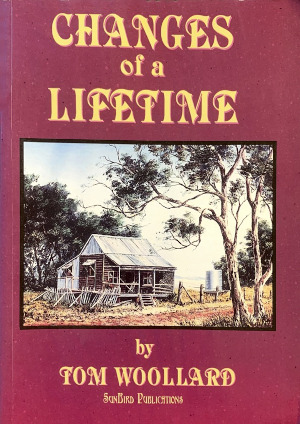 Author: Tom Woollard
Author: Tom Woollard
Tom has searched deep into his memory to give us detailed history of how life used to be when it was an everyday occurrence to rise before dawn and light the wood stove for the first cuppa of the day, a challenge to move cattle long distances to market without the use of cattle trucks. Also, when the only light was a candle, and the depression was the backdrop of the struggle faced by most families living on the land.
“It is my sincere desire to dedicate my book to the memory of the previous generations, especially to those who came to Australia in the 1840 to 1860 era. These folk were the real nation builders who sought new lives and fortunes in a new and sometimes inhospitable land.”
Tom was born in 1927 and this book was first published in 1995. Tom’s memories and stories of this lifetime growing up in the Manning Valley, just outside Wingham, give us an insight into ways in which adversity was faced and conquered in the past. Tom’s extensive contribution to the community was honoured by a Premier’s Award in 1992, but even more widely in the hearts of those his goodwill touched.
Second-hand book – good condition
164 pages with black and white photographs
17.5cm x 24.7cm
Reprinted 1996 (now out of print)
Cost $45.00
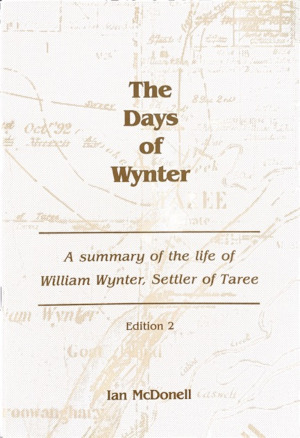
Author: Ian McDonell
Ian McDonell is the son of Frederick Barton McDonell and Fanny Elizabeth Wynter. Fanny
was a descendant of William Wynter. Ian states that this is “…the short but important story
of the man who settled a north coast river estate, the place now named Taree: my home
town.”
“Much of a story such as this is personal opinion, reasonably structured, and interwoven
with established facts. There is no intentional or mischievous mishandling of historical
facts.”
Second-hand book – good condition
28 pages with family tree timelines and one black and white photo of a local map.
14cm x 22cm
Printed in 1989 (out of print)
Cost $5.00
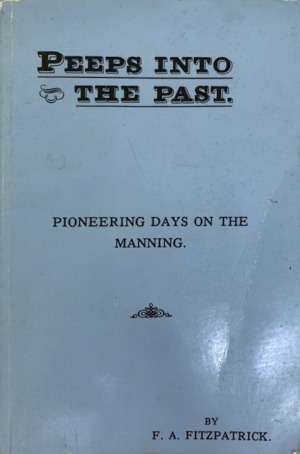
Author F. A. Fitzpatrick
First published in 1914. Reprinted in 1986
Pioneering Days On The Manning
Frederick Arthur Fitzpatrick was born at Windsor, NSW in 1873 where he grew up and was
educated. He entered the journalistic world as an apprentice with the Windsor and
Richmond Gazette, in 1888. After a period with the Molong Argus, he came to Wingham in
1909. Here he took a position with the Wingham Chronicle.
In 1912 he became Managing Editor and Director, becoming the sole proprietor in 1938. He
continued this position until he retired from active journalism. As well as conducting the
Wingham Chronicle he contributed to a number of newspapers and journals including the
Sydney Morning Herald and the Bulletin. F. A. Fitzpatrick died in 1958.
During his life he was closely associated with Local Government, serving as an Alderman on
Windsor, Molong and Wingham Council.
He was an astute observer of contemporary social history, collecting and recording many of
his observations and reminiscences of the early residents of this district. He may well be
called the father of local history in the Manning Valley.
Second-hand book – good condition
196 pages with some black and white photographs
18cm x 12cm
Reprinted 1986
Cost $50
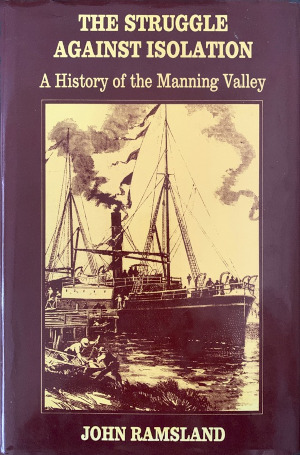
Author: John Ramsland
The author was commissioned by the Greater Taree City Council at the beginning of 1985 to research and write this comprehensive history of the Manning River Valley as the City’s major contribution to the Bicentennial Celebrations.
“This book is about the people of the Manning and the history of their existence in the region since 1770. The Aborigines had already been on the Manning for thousands of years when the first few European settlers began to invade the valley in 1827. Their motive in establishing permanent settlement was to provide a healthy, prosperous life for their families and to reap the potential commercial harvest from the valley’s natural resources. The Aborigines, on the other hand, sought to maintain their traditional and subtle way of life based on hunting, fishing and food gathering, with as little alteration to the valley’s natural environment as possible. The European culture and the Aboriginal culture were very different from one another and some kind of clash was inevitable. The collision and eventual accommodation between the invading European civilisation is an important historical issue despite the patchiness of local documentation on the matter.”
Second-hand book – good condition
336 pages with black and white photos and illustrations
16.7cm x 25cm Hard Cover
Published 1987 (out of print)
Cost $45.00



 Compiled and written by Jim Revitt
Compiled and written by Jim Revitt Author: Tom Woollard
Author: Tom Woollard

